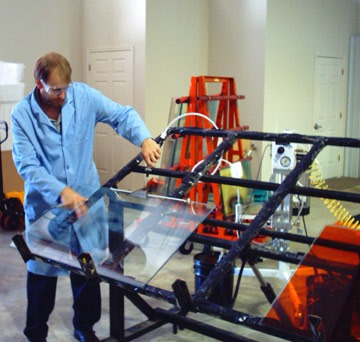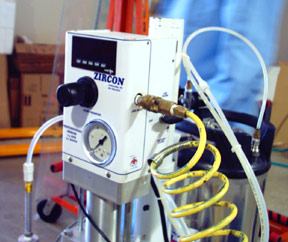
Glass
Lamination
Applications
Glass Lamination Resins
Zircon supplies high performance liquid resin systems, for glass and plastic lamination, which can be used to fabricate:

- Hurricane Resistant Glass
- Bullet Resistant Glass
- Decorative Glass
- Solar Insulated Glass
- Sound Deadening Glass
- Spandrel Glass
- Glass Clad/Polycarbonate
- Laminated Mirrors
- Laminated Etched Glass
- Radiation Reflective Glass
click here
Zircon Corporation
322 Moore Lane
Collierville, TN 38017
(800) 343-0964
(901) 850-0561
fax (901) 850-0563
info@zirconcorp.com
© 2003 Zircon Corp.
Advantages
Capital Expenditures
Using the double glass process, no autoclav, ultra-violet curing ovens or heat ovens are required. Capital expenditures are at a minimum. Although a glass washer is recommended, the float glass can be cleaned by hand. Only equipment to cut glass to size and a tilt table are required. Ten to fifteen pieces of insulated glass per day can be made using this method. This method is designed for specialty glass production.
Energy Dependence
No heat, light or pressure is required with the Cold Cure Liquid Glass Lamination Process. Only the ability to mix and place said mix between glass is necessary. The cold cure aspect of this process makes it easy to laminate mirrors, film, plastic castings, wood, metal parts, and marble.
Labor Dependence
With the Double Glass Method, a single worker can produce ten to fifteen pieces of laminated glass per day. This assumes that glass cutting equipment, glass cleaning equipment, a tilt table, and adequate mixing equipment is available. If a single worker were making exclusively, 8 ft. by 4 ft. pieces of laminated glass, the monthly production would be 6,400 to 9,600 sq. ft. (2.7-4.0 drums of liquid resin).
Response Time
Specialty and difficult to make glass laminates can easily be fabricated and installed the following day. Response time is a major advantage of the Zircon Cold Cure Liquid Glass Lamination Process.
Installation Yields and Inventory
Normally, a local glass shop will purchase a small billet (1,250 sq. ft.) or a large billet (2,400 sq. ft.) from a distributor. This material represents a sizable inventory. With the Zircon liquid system, a laminated piece of glass can be made to size and can be installed the next day. If necessary, the laminated glass can be easily cut.
With the Zircon cold cure process, a variety of glass laminate thicknesses can easily be done.
Versatility
With the Zircon Cold Cure Liquid Glass Lamination Process, the glass fabrication uses a fluid liquid resin. Liquids seek their own level, enabling the manufacture of bent glass, glass structures that are irregular in surface (tempered glass), and decorative glass that may vary in thickness. Tints, fillers and pigments can be incorporated into the resin mix. Lamination is not restricted to glass. Films, plastic sheets, wood, and metal substrates can be laminated to float glass. The system is so versatile that applicators are only restricted by lack of imagination.
